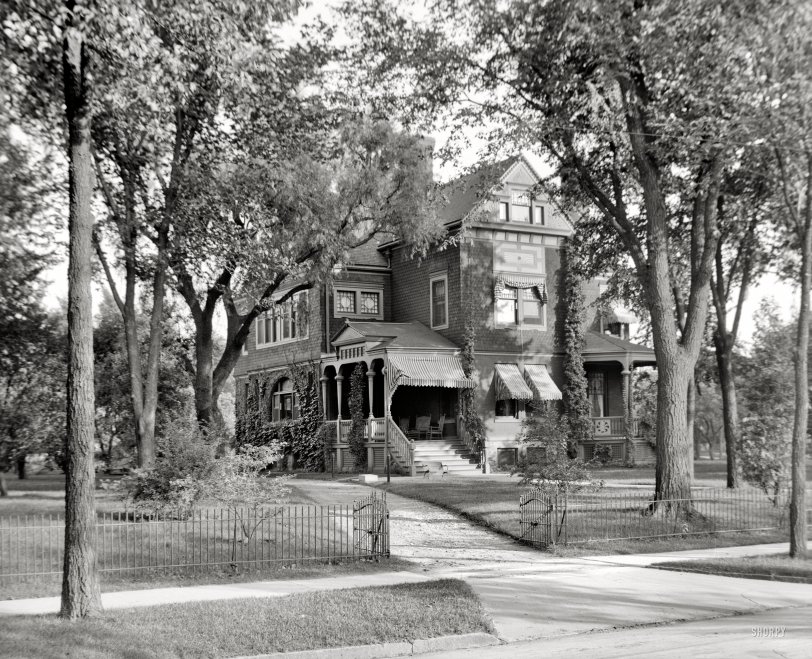


Framed or unframed, desk size to sofa size, printed by us in Arizona and Alabama since 2007. Explore now.
Shorpy is funded by you. Patreon contributors get an ad-free experience.
Learn more.

- Baldwin 62303
- Baldwin VO-1000
- Cold
- No expense spared
- Tough Guys
- Lost in Toyland
- And without gloves
- If I were a blindfolded time traveler
- Smoke Consumer Also Cooks
- Oh that stove!
- Possibly still there?
- What?!?
- $100 Reward
- Freeze Frame
- Texas Flyer wanted
- Just a Year Too Soon
- WWII -- Replacing men with women at the railroad crossing.
- Yes, Icing
- You kids drive me nuts!
- NOT An Easy Job
- I wonder
- Just add window boxes
- Icing Platform?
- Indiana Harbor Belt abides
- Freezing haze
- Corrections (for those who care)
- C&NW at Nelson
- Fallen Flags
- A dangerous job made worse
- Water Stop
Print Emporium
Potter House: 1907

Saginaw, Michigan, circa 1907. "Dr. Henry C. Potter's residence." 8x10 inch dry plate glass negative, Detroit Publishing Company. View full size.
Watch your buggy step please
Between the two hitching posts near the front porch is a square stone buggy step. They still survive here and there when not in the way such as mow strips between a sidewalk and the street.
[Also called "mounting blocks." - Dave]
1404 S. Jefferson Ave.
This is 1404 S. Jefferson Ave near the corner of Jefferson and Holland. This entire block no longer exists today.
Henry Camp Potter 1823-1909
Born at Utica, New York, on January 14, 1823; died at San Ysidro Ranch near Santa Barbara on April 3, 1909, three months after his son Henry Jr. committed suicide.
He had led a full and interesting life, counting among his friends newspaper editor Horace Greeley, US Secretaries of State William H. Seward and James G. Blaine, and poet John Greenleaf Whittier. Before he died, he was one of the last remaining people to have heard Daniel Webster speak. Although he was a physician, getting his MD degree from Albany Medical College in 1844, Dr. Potter practiced medicine less than ten years. In 1852, he went into the public works construction business with his father-in-law, Samuel Farwell. That connection brought him to Saginaw in 1859 where he oversaw the building of the Flint and Pere Marquette Railroad. Dr. Potter served as treasurer, general manager and vice-president of that railroad until his retirement in 1891. In addition, he was instrumental in establishing the first salt company in the area, served on various bank boards and was conspicuously active in Saginaw civic affairs.
Dr. Potter was 86 when he died, old enough to have survived his wife of nearly 59 years, Sarah, and all four of their children. Helen died in 1864; James in 1879; William, president of the Long Island Railroad, in 1905; and, finally, Henry Jr., vice-president of the People’s State Bank of Detroit, by his own hand in 1909. It was said that last death likely did much to hasten Dr. Potter’s end.
What's missing today
Craftmanship. The skill and artistry to produce intricate and quality wood products today is uncommon and we are the poorer for it.
Voldemort Ivy
He who shall not be named is creeping up the side of the house.
Dr. Potter (1823-1909)
Dr. Henry C. Potter's greatest accomplishment was the building and management of the Flint and Pere Marquette Railroad, which he undertook along with his father-in-law. He also formed and ran the Savings Bank of East Saginaw, from 1872 until the year of this photo. According to his biography in the "History of Saginaw County," "In his beautiful home, at Jefferson and Holland Avenues, he was a prince of hosts, courteous, hospitable, and ever thoughtful of the comfort and pleasure of his guests."
A Wealthy Man
And did he ever call his daughter's beau "That son of a Saginaw fisherman"?
Bathroom Suicide
Jan 5, 1909, N.Y. Times.
Dr. Potter's son:
HENRY C. POTTER Jr. A SUICIDE; Michigan Banker Was Suffering from Nervous Depression.
DETROIT, Mich., Jan. 4. -- Henry C. Potter, Jr., of the People's State Bank of this city, Secretary and Treasurer of the Flint Pere Marquette Railroad from 1884 to 1900, and a prominent figure in financial circles of Michigan, committed suicide to-day in the bathroom of his residence by shooting himself through the head.
Tranquility
I look at this photo and say to myself, "The world has gotten too d@mn complicated." To sit on this porch in 1907 with a glass of lemonade and the evening paper, perhaps I would give up the comforts and technology of 2011. For back in 1907, if something had to be done or someone had to be contacted, it could just wait until tomorrow.
Southern Exposure
Before air conditioning was common, south facing windows were often equipped with such shades.
I'd live there
But only if I could afford a housekeeper. And she better do windows, too.
The house knows how to accessorize
I love the windows and awnings. You don't see windows all dolled up like that anymore. Not on the outside anyway.
























On Shorpy:
Today’s Top 5